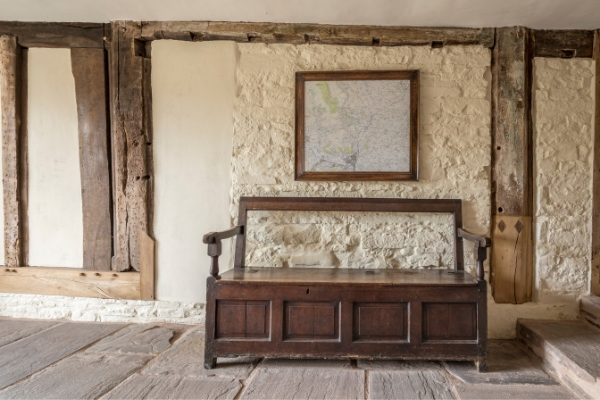
The house dates to 1420
Grade-I listed, Llwyn Celyn has been dated by timber analysis to 1420. The house has changed little since the late-17th century, and it is chiefly this period that Landmark’s restoration seeks to highlight. Despite much research, we still do not for sure who built this core house at Llwyn Celyn, or why. When constructed, the house was part of the Llanthony Priory estate, and it was built just as Wales emerged from a period of great upheaval. Successive waves of plague from 1349 to 1400 were followed by the destruction of Owain Glyndŵr's Rising of 1401-15, done by Glyndŵr’s army and the English alike. Very few vernacular Welsh houses survive from this period, and this makes Llwyn Celyn, as an exceptionally high status house for its day, all the more intriguing.
Llwyn Celyn still has its classic medieval floor plan. As first built, it had a 3-bay central hall, open to fine roof timbers, up to which smoke rose from a fire in the middle of the floor. This counts as a large house for the day, and the hall was the central living space for the whole household. The master of the household sat at a big table at the ‘high’ end, and the fixed bench here is a rare survival. At the ‘low’ end of the hall, beyond a wooden screen or partition, ran a cross passage, and beyond that were the buttery and the pantry, for storing wet and dry goods respectively.
A rare two-storey solar wing
The two-storey solar wing is primary, and another rare feature. It was probably reached by a tight, intramural spiral stone staircase leading up from the hall (now lost) but whose pointed doorway was uncovered during the restoration. The solar provided fine, private chambers for the ‘lord’ or master of the household and was also accessed at ground floor level from the high end of the hall through a finely carved wooden doorhead with blank shields. There are two even finer doorheads in the cross passage. These doorheads are exceptional in a Welsh domestic context.
Equally unusual is the survival of a spere truss. A truss is an arch that supports the roof, and a spere truss is a more decorative one extending down to the ground floor, with an opening to provide a ceremonial entrance to a hall. At Llwyn Celyn, its timbers can still be seen in the cross passage. Before the chimneystack blocked it, a central opening in this spere truss gave a direct view of the two fine doorheads in the cross passage from the high table. Llwyn Celyn was clearly built for someone of great status, perhaps even for the prior of Llanthony Priory himself.
A history bound up with the Llanthony Priory
Llwyn Celyn’s history is bound up with the Augustinian Llanthony Priory, which from the early 12th century owned the land on which Llwyn Celyn is built. The priory was suppressed in 1538, along with Llanthony Secunda in Gloucester, with which it had been merged in 1480. Llanthony-in-Wales by then was a religious house in considerable disarray.
The priory estates were bought in 1546 by a rich lawyer, Nicholas Arnold, whose family owned them until 1726. From then on, Llwyn Celyn became a tenanted farm. The 16th and 17th centuries were a time of unusual prosperity for the Llanthony tenant farmers. Low rents on long, copyhold leases and rising produce prices meant the profits of the land stayed with the tenant farmers rather than passing to the landlords. This created a class of independently minded, prosperous yeomen and gentry tenant farmers. They farmed steep slopes, but also had grazing rights on common and waste land on the peaks. The mountains’ geology yields good building stone in naturally cleaved blocks. All this allowed the farmers to build other good, sound farmhouses and outbuildings, which still dot the valley today.
The Watkins of Llwyn Celyn
The Watkins of Llwyn Celyn were one such farming dynasty and around 1690, big improvements were made in the house. William Watkin, or possibly his brother Thomas, inserted a ceiling into the open space of the hall to create a large chamber above on the first floor, reached by a new wooden staircase put in alongside a huge new chimney stack for a fireplace and bread oven (which we found behind a 20th-century fireplace). At the same time, a separate kitchen was added at the back of the house, with another bread oven. A beast house and little building beside the threshing barn (which therefore predates 1695) were built in the same years, and probably the cider house and piggery too. The Watkins created Llwyn Celyn as we see it today, and after them, little changed in the house. By now the farm had all the usual buildings needed for self-sufficiency: a threshing barn, cider house, beast house, stables, pigsty and kiln houses for drying malt for brewing and corn. As these reflect, the farming done was mixed, arable and livestock making the best of both lush valley fields and the high mountain wastelands.
Llwyn Celyn in recent times
 From the mid-19th to the mid-20th century Llwyn Celyn was farmed by the Jasper family. In 1958, Llwyn Celyn was bought by their relatives Tom and Olive Powell, whose sons Trefor and Lyndon still own and farm the land around. By the 21st century, Llwyn Celyn’s buildings were in a state of severe dilapidation, its fabric suffering from rain and run-off from the hillside. In 2007, Cadw approached the Landmark Trust to help. A complicated acquisition deal was struck, enabled by grants from Cadw and the National Heritage Memorial Fund, and allowing a new home to be built for the Powells.
From the mid-19th to the mid-20th century Llwyn Celyn was farmed by the Jasper family. In 1958, Llwyn Celyn was bought by their relatives Tom and Olive Powell, whose sons Trefor and Lyndon still own and farm the land around. By the 21st century, Llwyn Celyn’s buildings were in a state of severe dilapidation, its fabric suffering from rain and run-off from the hillside. In 2007, Cadw approached the Landmark Trust to help. A complicated acquisition deal was struck, enabled by grants from Cadw and the National Heritage Memorial Fund, and allowing a new home to be built for the Powells.